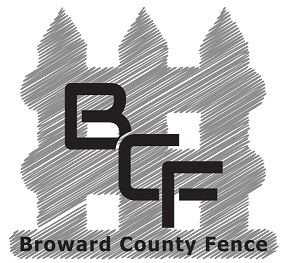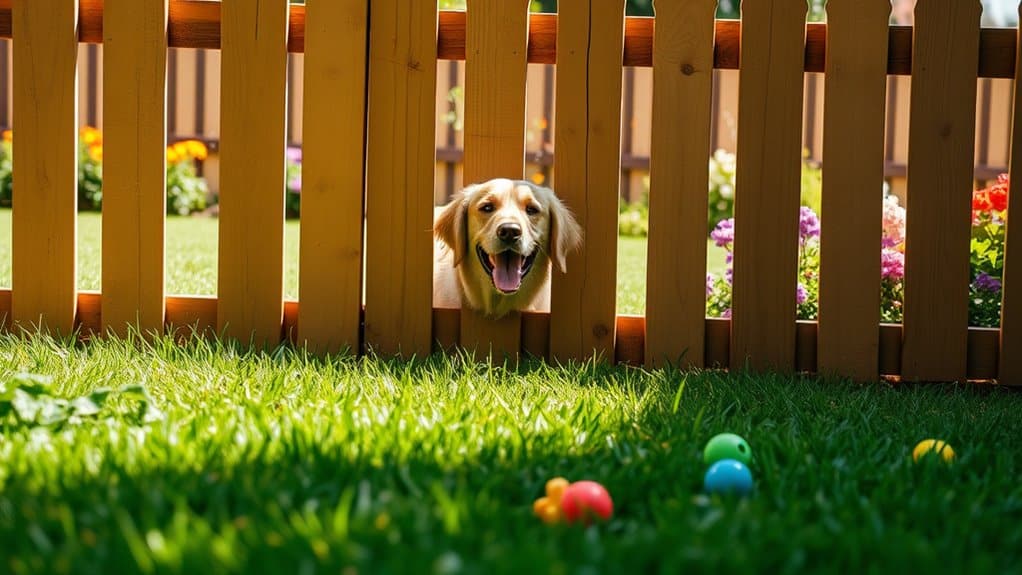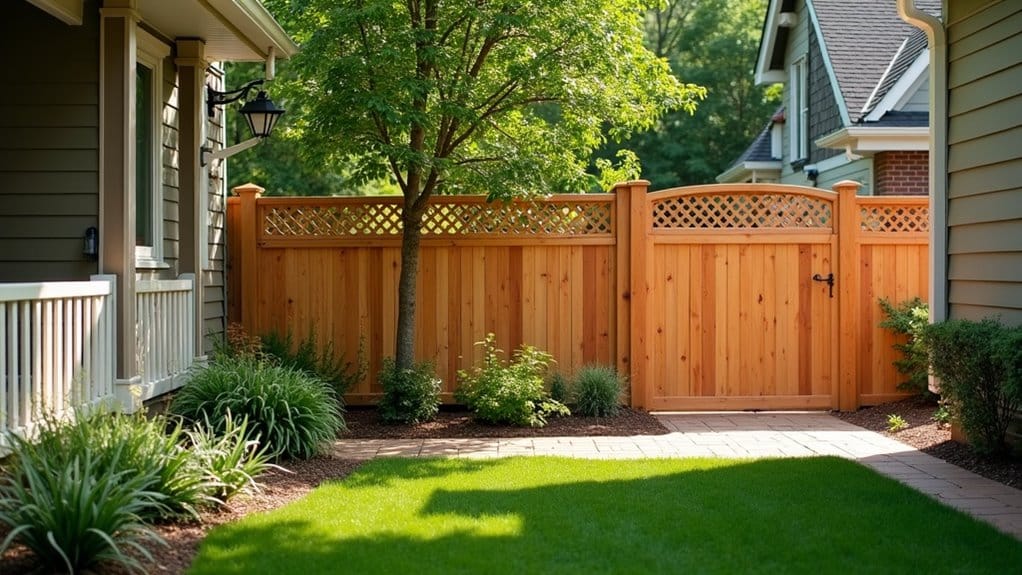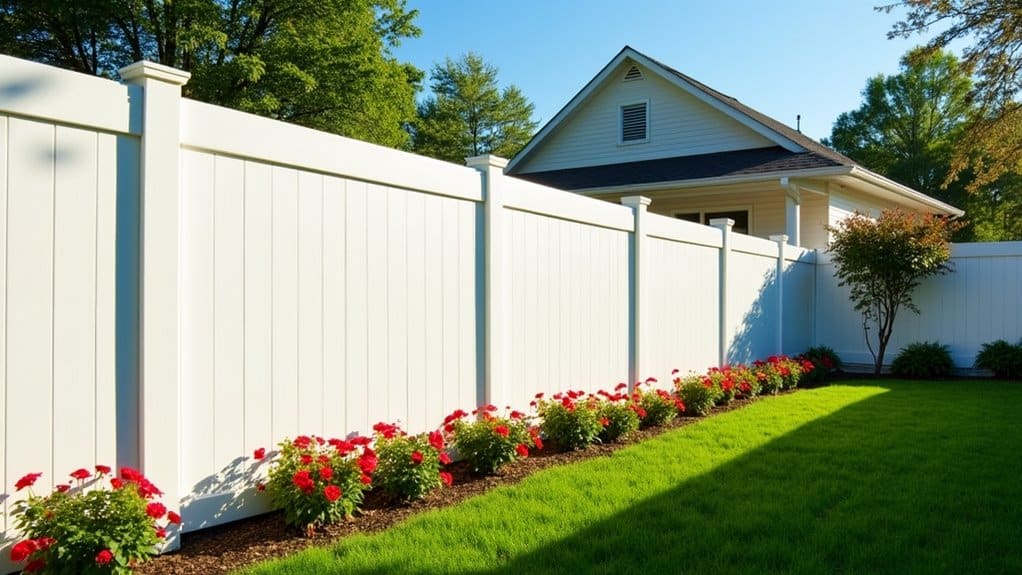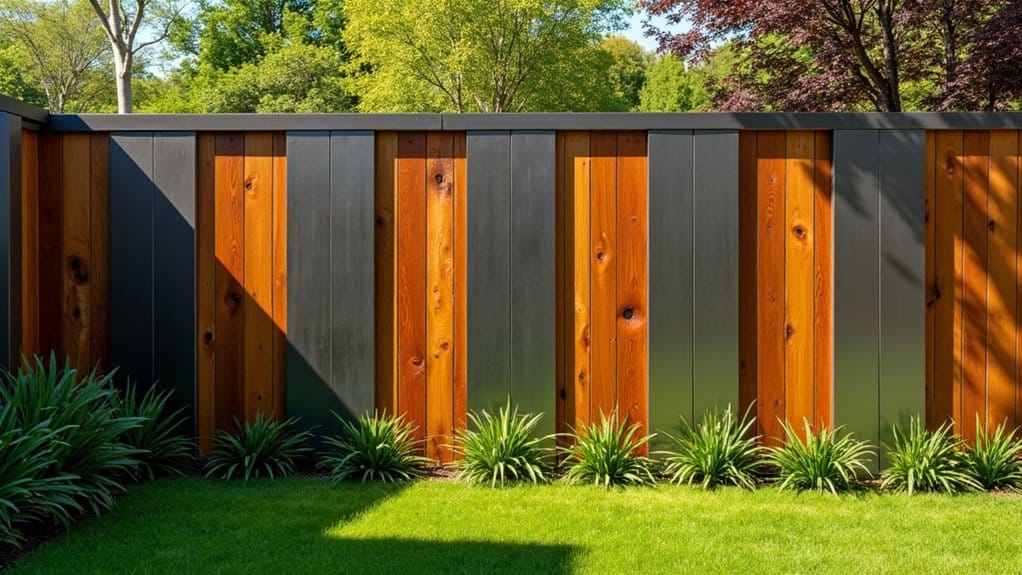To keep your pets safe, choosing the right fencing is crucial. For small dogs, go for wooden or vinyl fences with narrow gaps to prevent escape. Larger breeds require sturdy metal fences that are at least 6 feet tall, depending on how high your dog can jump.
Vinyl fences are durable and low-maintenance, while wood adds a classic look but needs more care. Ensure gates are secure and consider burying the fence to stop digging. Regularly check the fence for any damage or gaps. Each type of fencing has its own advantages tailored to your pet's needs, so pick the one that suits your furry friend best.
Key Takeaways
- Choose a fence height based on your dog's size: 3-4 feet for small dogs, 5-6 feet for large breeds, and taller for jumpers.
- Use durable materials like vinyl or metal for easy maintenance; wood needs regular care to stay in good shape.
- Make sure your fence is secure with features like dig-proofing and check it regularly for safety.
- Check local regulations and HOA rules; most neighborhoods allow fences up to 6 feet tall without needing a permit.
- A good fence not only keeps your pets safe but also boosts your home's curb appeal; look for styles and colors that complement your house.
Choosing the Right Fence Type
When choosing the right fence for your pets, consider their size and behavior. Small dogs do well with wooden or vinyl fences that have narrow gaps for security and privacy. For larger, energetic dogs, opt for sturdy aluminum or metal fences at least 6 feet tall to prevent escapes. Additionally, solid fences can provide excellent wind protection without compromising security.
Think about how the fence will look in your yard. Wooden fences have a classic appeal, while vinyl comes in various styles and colors to suit your taste. Additionally, consider that digging breeds may require extra reinforcements at the bottom to prevent tunneling underneath. It's also important to assess local regulations regarding fence heights and materials to ensure compliance.
Also, ensure the fence allows enough space for your pets to roam freely while minimizing distractions from neighbors.
Don't forget security features. Make sure gates are secure and out of your pets' reach, and consider adding anti-climb spikes for extra protection. Regular maintenance of the fence is also crucial to ensure continued effectiveness and safety for your pets.
Balancing these factors will help create a safe and appealing environment for your furry friends.
Fence Height Considerations
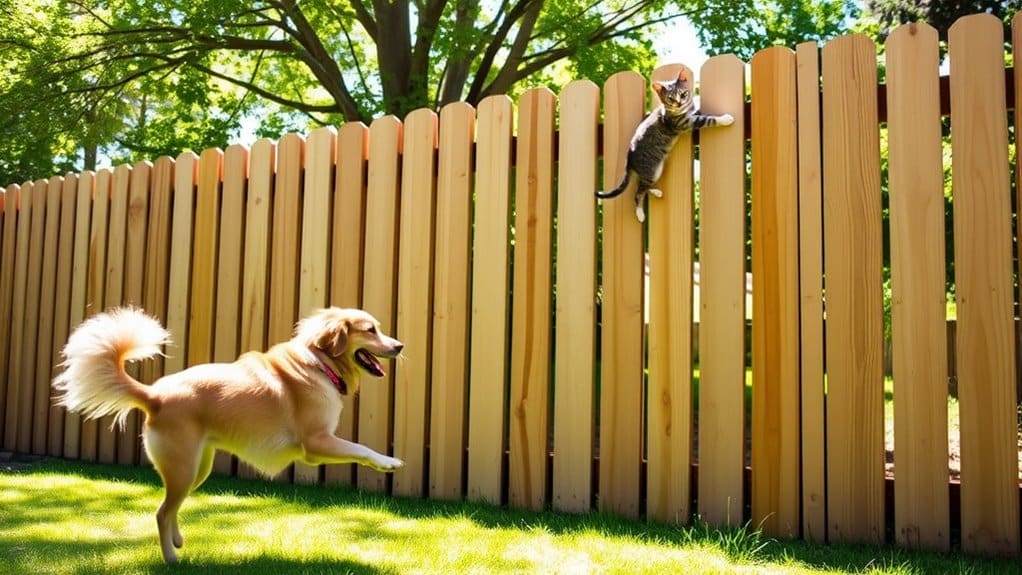
When choosing a fence height, consider your pet's size and breed to ensure their safety. For example, larger breeds may require taller fences to prevent jumping. Additionally, be aware of the maximum fence height set by local regulations to ensure compliance. Also, check local regulations for minimum height requirements. A well-designed fence not only enhances safety but also establishes appropriate boundaries for your pets to roam freely.
Minimum Recommended Heights
Choosing the right fence height is key to keeping your pets safe. Here's a quick guide:
- Small dogs: A fence height of 3 to 4 feet usually does the job.
- Medium-sized dogs: Aim for 4 to 5 feet.
- Large breeds: A minimum of 5 to 6 feet is necessary to keep them contained. Local zoning ordinances may also dictate exact height limitations that you should consider when planning your fence.
If your dog is an agile jumper, consider a fence that's 6 to 8 feet tall. Generally, a 6-foot fence can contain about 99% of dogs, but knowing your dog's jumping ability is crucial for your decision. Additionally, high-energy breeds often require taller fences due to their capabilities and determination.
Also, consider the fence material and design, as they impact both safety and appearance. Regular maintenance is essential to prevent weak spots.
Combining the right fence with proper training will create a secure environment for your furry friends.
Breed-Specific Height Needs
Choosing the right fence height for your dog depends on their breed and behavior.
For small breeds like Terriers and Dachshunds, a fence height of 3 to 4 feet usually works. If your small dog is particularly agile, opt for a 4-foot fence to prevent escapes. Additionally, it's important to consider escape tendencies when selecting the fence height for small breeds. A privacy fence can also help minimize distractions that may encourage small dogs to jump.
Medium breeds, such as Bulldogs and Beagles, need at least a 5-foot fence. A 4-foot fence may tempt them to jump, so a taller option is safer.
Large breeds like Labradors and German Shepherds require a fence of 6 feet or more, as they often see shorter fences as a challenge.
For breeds that love to jump, such as Huskies and Border Collies, a 6-foot fence or taller is essential to keep them secure and safe.
Local Regulation Compliance
When choosing the right fence height for your dog, it's crucial to consider local regulations. These rules can differ significantly in each area, so it's essential to understand them before starting your fencing project.
Here are some important points to keep in mind:
- Maximum Height: Most residential areas allow fences up to 6 feet high without needing a permit.
- Permit Requirements: If your fence will exceed 6 feet, you'll probably need to apply for a special permit.
- HOA Rules: If you live in a Homeowners Association (HOA) community, check their guidelines, as they might've additional restrictions. Additionally, knowing the specific local ordinances can help you avoid potential issues with fence construction.
Staying compliant with these regulations not only helps you avoid fines but also ensures the safety of your pets and your neighbors. A well-installed fence that meets local standards minimizes disputes and keeps your furry friends secure, especially when you consider that a 6-foot height can contain approximately 99% of dogs.
Always consider your community's specific rules when deciding on fence height to promote safety and harmony.
Material Durability
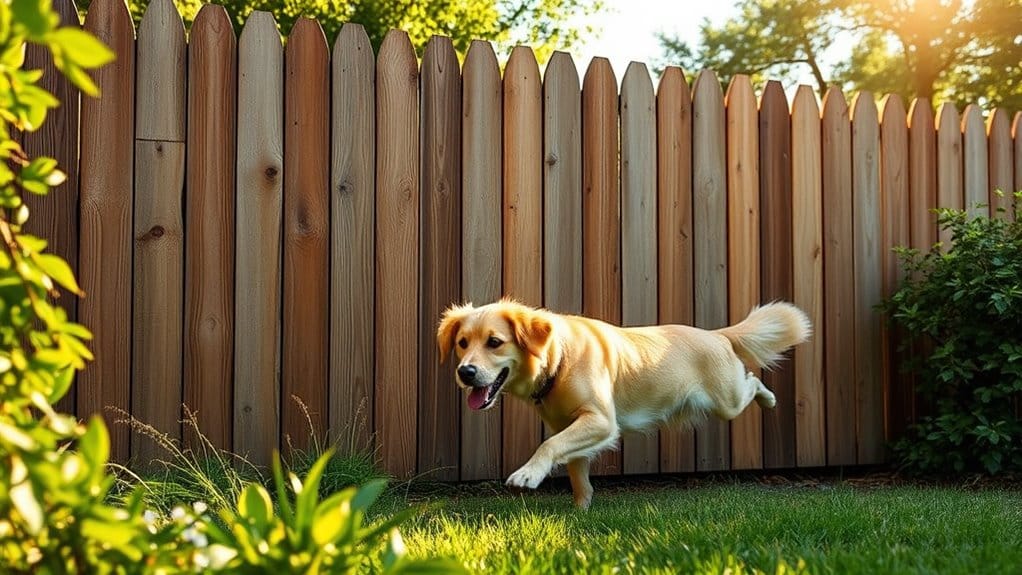
When choosing a fence for your pet, durability is key. The right materials can keep your furry friend safe and secure.
Vinyl fencing is an excellent choice due to its long-lasting nature. It withstands harsh weather, extreme temperatures, and UV rays without scratching easily, making it ideal for active pets. Additionally, understanding individual pet behaviors can help you select the most suitable fencing that complements their needs.
Wooden fencing is attractive but needs regular maintenance to prevent issues like rotting and warping. If you opt for wood, be ready for repairs and be cautious of toxic treatments that could harm your pets.
Metal fencing is sturdy and can last over 20 years with proper care. Aluminum resists rust, while steel and iron require occasional maintenance, like repainting.
Chain-link fencing is durable and budget-friendly, but it may lack privacy for some pets. Adding roll bars can enhance safety.
Installation Considerations
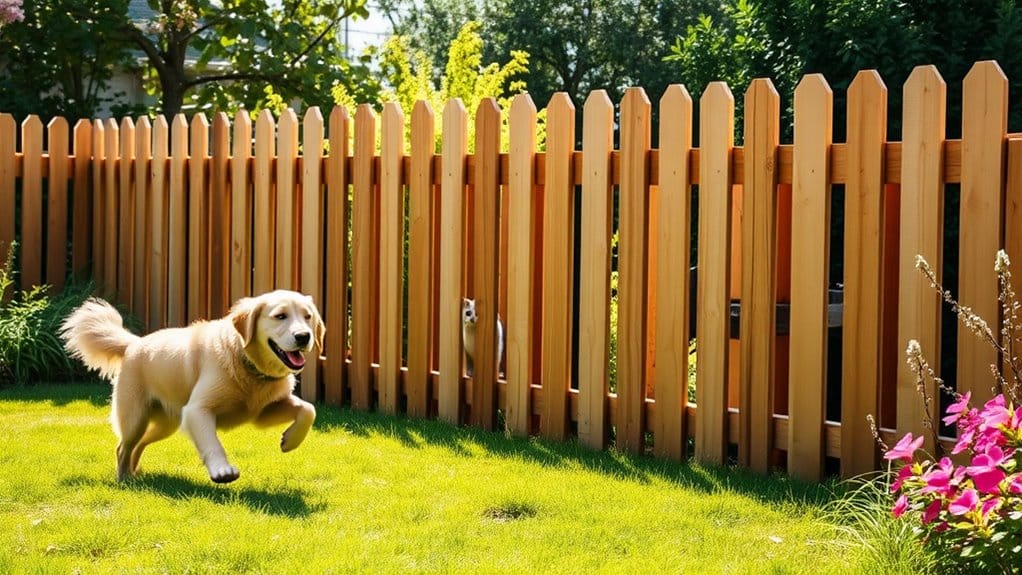
When installing a fence for your pet, consider these key factors to ensure safety and effectiveness:
- Pet Behavior: Know your pet's tendencies. If they're known to escape, opt for a taller fence or extra security measures.
- Future Landscaping: Think ahead about any garden changes to prevent costly adjustments later.
- Installation Method: Choose between above-ground or buried wire. If burying, make sure the wires are well-protected and tested first. Electric fences are adaptable to terrain, providing an effective solution for various yard layouts.
Training is also crucial. Tailor your methods to your pet's behavior to help them adjust and stay safe.
Safety and Security

To create a safe environment for your pet, proper fence installation is key. Choose the right fencing type to keep your furry friend secure and comfortable. Wooden and vinyl fences provide privacy and durability, while chain-link fences allow visibility but may not stop pets that are determined to escape.
Consider adding features like dig-proofing by burying the fence or using specialized materials. High latches that pets can't reach are essential to prevent accidental escapes. Planting thorny bushes near the fence can also help deter pets from getting too close.
Assess your pet's size and behavior when selecting a fence. Taller fences are better for large, jumpy breeds, while smaller gaps can keep tiny pets secure. Additionally, regular inspections for damage will help identify and address any potential escape routes.
Regular maintenance is crucial—check for wear and tear to ensure safety. By choosing the right materials and keeping everything in good shape, you can create a secure space where your pets can play safely in your yard.
Cost and Value
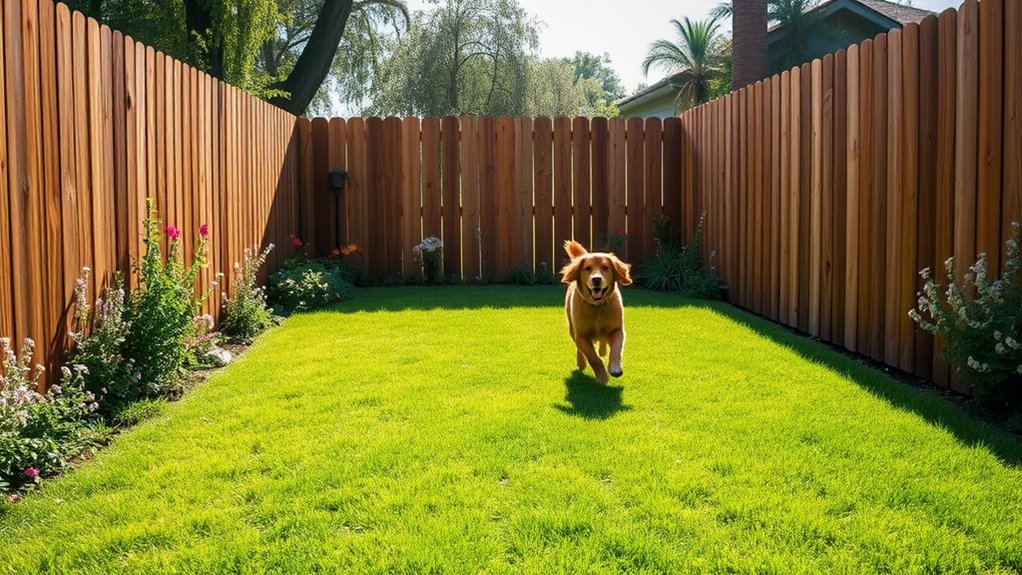
When selecting a fence for your pet, it's important to understand the costs and values of different options. On average, installing a dog fence costs around $4,700, but this can vary based on factors like:
- Type of Fence: Wood, vinyl, chain link, and electric fences each have different price ranges.
- Size of Property: More extensive areas need more materials and labor.
- Location: Prices can differ by state and region.
Consider the long-term benefits of your investment. A wood fence typically costs between $1,000 to $4,500, offering durability and an attractive look. Additionally, installation costs for electric fences can range from $1,300 to $2,500 per acre, which is essential to factor into your budget.
On the other hand, chain link fences are more budget-friendly, ranging from $1,500 to $4,000, while still providing good visibility and security for your pets.
In the end, weigh the initial costs against the lasting value of your chosen fence to ensure your pet stays safe and secure.
Recommended Fencing Options
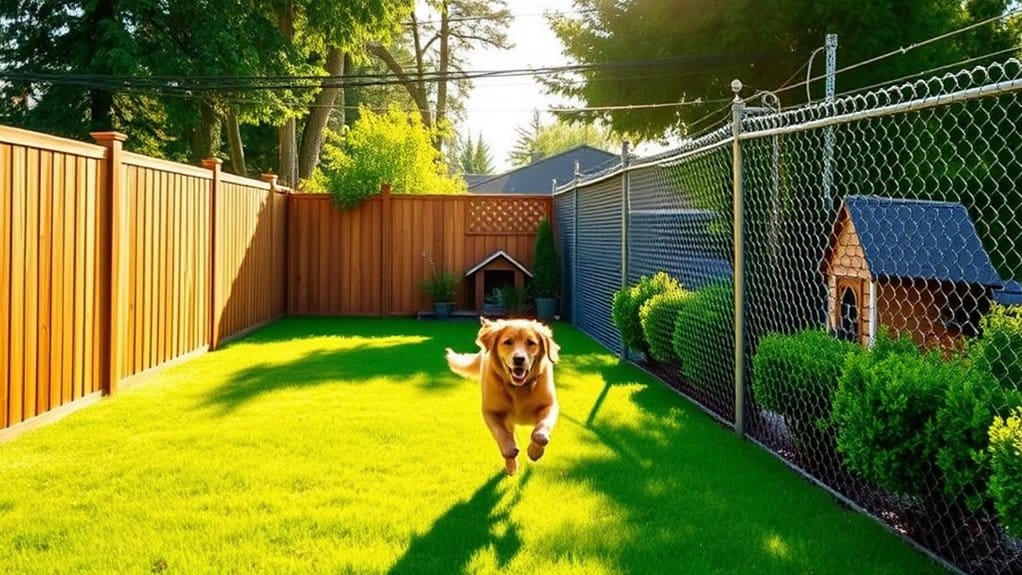
When picking a fence for your pet, consider the material's durability and height for safety. Options like wood, vinyl, and chain-link each have their pros and cons that affect how well they keep pets secure. Make sure the fence is tall enough to prevent jumping, especially for agile pets that love to escape. Additionally, the height requirements vary by dog size, so be sure to choose an appropriate height based on your pet's breed.
Material Durability Comparison
Choosing the right fencing material is crucial for keeping your pets safe and happy. Here's a quick rundown of popular options based on durability and safety:
- Vinyl Fencing: Low-maintenance and weather-resistant, vinyl is smooth, reducing the risk of splinters. However, it can wear down faster in extreme weather.
- Wood Fencing: A traditional option, wood is sturdy but needs regular upkeep to prevent rot. The type of wood you choose will affect how long it lasts.
- Chain-Link Fencing: Affordable and easy to care for, chain-link provides visibility and can help prevent escapes. However, it mightn't be the best choice for pets that are climbers or jumpers.
- Metal Fencing: Very durable and requires little maintenance, metal fences can last for years. Just be cautious of ornamental designs, as they may have gaps that pets could slip through.
Height and Safety Considerations
To ensure your fencing keeps your pets safe and meets their needs, consider the fence height carefully. For most dogs, a minimum height of 6 feet is crucial to prevent jumping. Small breeds may be fine with a 4-foot fence, while larger breeds may need even taller barriers. Here's a quick reference:
| Dog Size | Recommended Height | Jumping Risk |
|---|---|---|
| Small Breeds | 4 feet | Low |
| Medium Breeds | 6 feet | Moderate |
| Large Breeds | 6-8 feet | High |
| Active Breeds | 8-10 feet | Very High |
| Elevated Yards | 8 feet or more | Critical |
Along with the right height, use secure latches and sturdy materials to enhance safety. Ensure there are no narrow gaps that could allow escape. Choose fence materials that fit your yard's look while serving your pets' needs. Regularly check the fence for maintenance to keep your pets safe and happy.
Maintenance Tips for Fences
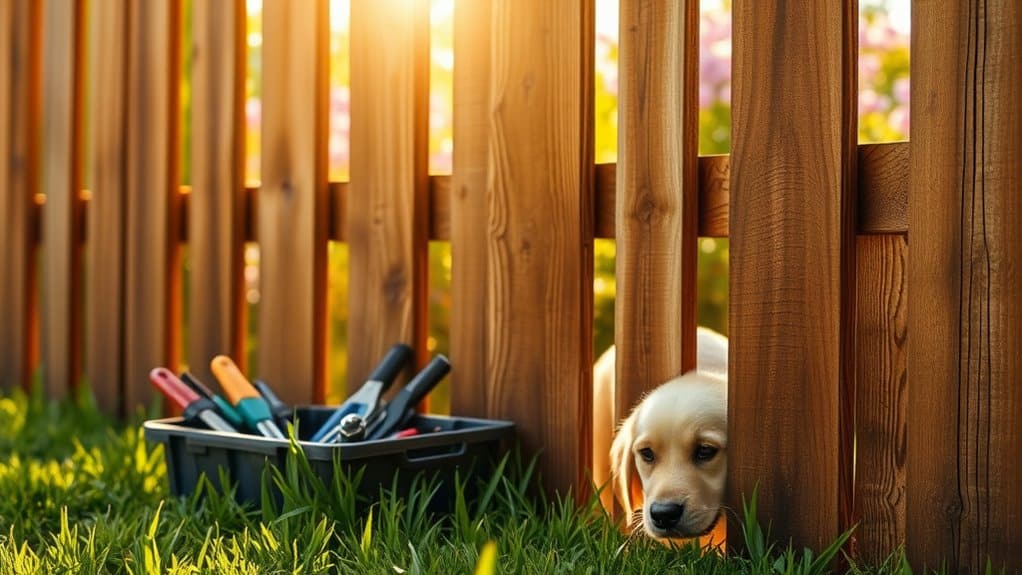
Maintaining your fence is crucial for your pets' safety and your yard's appearance. Here are some essential maintenance tips:
- Regular Inspections: Check for wear, rust, or damage. Look for gaps where pets might escape.
- Seasonal Checks: After bad weather, clean your fence and look for new damage. Trim any plants that could weaken it.
- Material Care: Different materials need specific care. For wooden fences, check for rot and apply stain or paint for protection.
Address any damage right away to keep your pets safe. Ensure gates are secure and that the fence is buried deep enough to prevent digging.
Enhancing Your Yard's Aesthetics
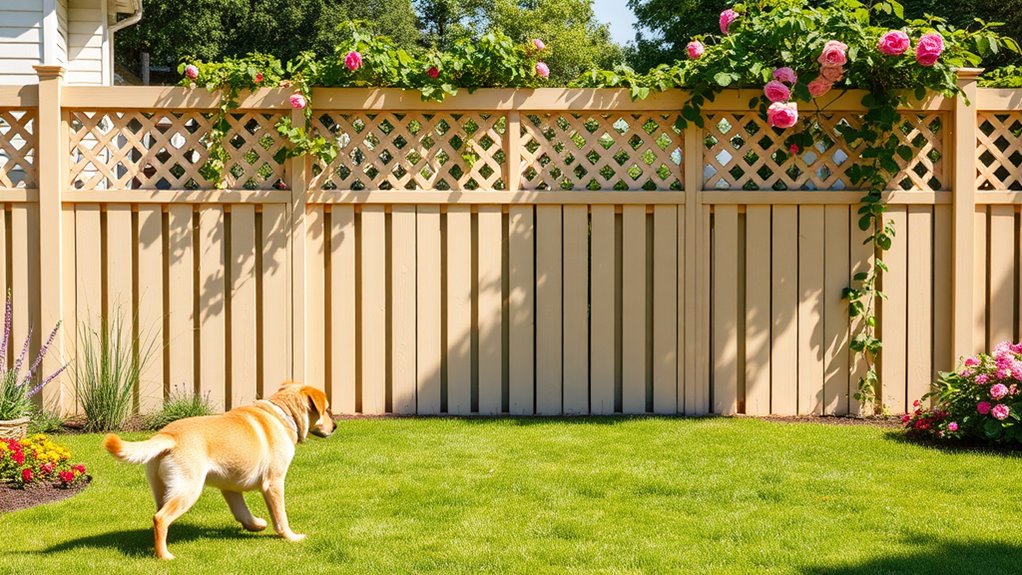
A beautiful yard boosts your home's curb appeal and keeps your pets safe. Choosing the right fence can enhance your outdoor space while securing your furry friends.
For a natural look, wooden fencing offers customizable colors that blend with your landscape. If you want something low-maintenance, vinyl fencing comes in various styles and colors for a modern touch. Wrought-iron fencing provides durability and sophistication, while chain-link can be improved with privacy slats for better aesthetics.
For elegance and safety without blocking views, consider aluminum fencing.
Adding decorative elements like climbing vines or hedges can create visual interest. Picket fencing has charm but may not be suitable for larger, active breeds.
Ultimately, balance aesthetics with safety by selecting materials that look good and meet your pets' needs, ensuring your yard is a beautiful and secure retreat for everyone.
Frequently Asked Questions
How Do I Train My Dog to Stay Within the Fence?
To train your dog to stay within the fence, use positive reinforcement. Reward them with treats and praise for staying close to the boundary. Start by keeping them on a leash and gradually allow more freedom as they learn. Consistent practice and supervision are key to their success. For example, if your dog stays within the yard while you're outside, give them a treat. This helps them understand where it's safe to roam.
What Are the Best Fence Types for Large Breeds?
For large breeds, opt for sturdy materials like chain-link or metal fences. Ensure they are at least 6 feet tall to deter jumping. Consider your dog's behavior and any potential escape attempts when selecting a fence.
Can I Use Multiple Types of Fencing Together?
Combining different types of fencing can boost security by up to 50%. For instance, pairing a tall wooden fence for privacy with a shorter chain-link fence can keep your pets safe while allowing visibility. This approach lets you customize height and privacy based on your needs.
How Do I Choose a Fence Color That Matches My Home?
To choose a fence color that complements your home, think about how colors influence mood and style. Pick shades that match your home's design and enhance its features. For example, a classic white fence goes well with a traditional brick house, while a dark gray fence can add a modern touch to a contemporary home. Ensure the color also fits well with the natural surroundings.
What Are the Best Landscaping Ideas for Fenced Yards?
For a great fenced yard landscape, aim for a balanced design. Use pet-friendly plants like ornamental grasses and sturdy ground covers. These choices not only beautify your space but also keep it safe for your pets.
Conclusion
Investing in the right fencing is crucial for your pets' safety and your peace of mind. While costs may be a concern, consider it a long-term investment in your furry friend's well-being. A strong, well-chosen fence not only secures your pets but also improves your yard's look. Prioritizing their safety creates a happy, healthy space for them to enjoy. Keep your pets safe and your yard looking great!
